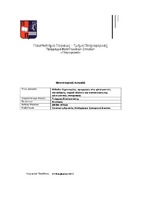Μέθοδοι δημιουργίας, εφαρμογές στις ηλεκτρονικές συναλλαγές, νομικό πλαίσιο και πιστοποίηση της ηλεκτρονικής υπογραφής

View/
Subject
Κρυπτογραφία ; Ψηφιακές υπογραφές ; Προστασία δεδομένων -- Δίκαιο και νομοθεσία ; Ηλεκτρονικό εμπόριοAbstract
In recent years we observe large and rapid changes in technology and especially in technology related to computers. In the second chapter we see that, the "electronic data", the "electronic transactions" and "electronic documents" have replaced their conventional counterparts. The first generated, processed, verified and archived electronically, i.e. without the need for incorporation into a medium such as paper. In this context we see that there is strong growth in electronic commerce and electronic transactions. The most important question that arises in electronic commerce (e-commerce) and more generally to electronic communications is that the security of transactions. In the third chapter we will see that, each user is doing business electronically over the Internet requires the data sent cannot be disclosed or made available to unauthorized people about it (confidentiality). The data should not be altered during transmission. The recipient should take them exactly as the sender sent them and be sure that the data received is what the sender sent (integrity). It is also necessary that the recipient can be sure of the identity of the sender (authenticity). Finally, participating in an electronic transaction should not be possible for parties to refuse subsequent participation in the transaction (no disclaimer). To meet all these requirements is the use of electronic signatures. The use of (advanced) "electronic signature" and "electronic identification certificates" are those that ensure the "authenticity" and "integrity" of electronic data, "Identification" of transacting and under conditions, "legally binding" the undersigned or otherwise 'non-waiver "of the transaction may also provide a reliable solution to the issue of" confidentiality "of data in their movement. In the fourth chapter we see that, for electronic signatures is of course a strict legislative framework at European and national level, in which defined the conditions and methods of operation and creation of electronic signatures and their legal effect. In the fifth chapter will introduce the system for delivering digital signature PGP (Pretty Good Privacy), which is one of the most popular programs for implementing digital signatures. Finally, the eighth chapter will create a website which will apply digital signature and digital certificate.


